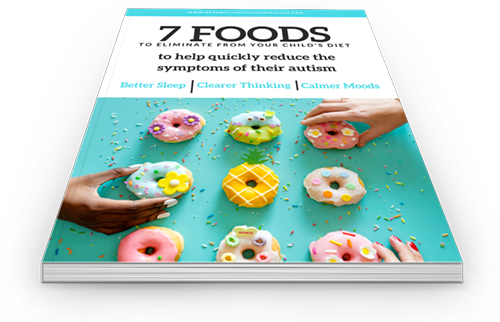It’s common in children, and adults, with autism to have speech issues. This can be a difficulty speaking clearly all the way to completely non-verbal, at any age.
Many symptoms come from various toxins, pathogens and coinfections. We begin with healing the gut and diet, but there is so much more involved. In my last podcast episode We discussed the toxicity of aluminum. In studies it has been noted that speech is one of the symptoms associated with speech issues of all kinds.
It’s never just one thing. Speech is helped by all of it, but for best results the complete A-Z approach must be done. As underlying common symptoms of speech issues with autism I find there are three issues that are an absolute must to be covered properly for best results.
Speech issues are caused by many things, but the top three I’ve found in my research and experience are:
- Aluminum
- Viruses
- PANS
Aluminum
How Do We Get Aluminum Exposure?
Aluminum is prevalent in our society in the air, soil/food, water, cookware, and in the health care products most people use daily such as deodorants, fragrances, lotions, make-up, and so much more. It is contained in antacids, over the counter supplements, and medications.
Almost 75% of all adjuvant-based medical treatments include aluminum salts.
Aluminum Poisoning with Emphasis on Its Mechanism and Treatment of Intoxication See Study here.
What Are The Health Risks of Aluminum Exposure?
Approximately 60% of the body’s aluminum is stored in the bones, 25% in the lung, 10% in the muscle, 3% in the liver, and 1% in the brain. Inside the cells, aluminum is stored in the lysosomes of brain neurons, liver, spleen, myocytes of the heart, smooth muscle cells, epithelial cells of the kidneys, and mitochondria. Aluminum also causes permeability of the mitochondria membrane (the cell’s energy source). Aluminum also causes destructive changes in the liver cells. This enhances proinflammatory cytokines.
The Neurological Effects of Aluminum on the Human Brain
Even small amount s of aluminum are harmful.
When aluminum loading occurs, aluminum gradually accumulates in human neurons, making them vulnerable. Studies have suggested that even small amounts of aluminum in the brain may alter iron homeostasis in the brain, causing neurodegenerative disorders.
Neurological manifestations of aluminum poisoning include:
memory loss,
tremor,
jerking movements,
diminished coordination,
weakness in motor movements,
lack of curiosity,
ataxia,
speech disturbances (dyspraxia, dysphasia, stuttering, and more),
myoclonic jerks,
and generalized convulsions
Aluminum’s causal changes in behavior and consciousness levels such as:
agitation,
confusion,
myoclonic jerk,
grand mal seizures,
obtundation,
coma,
Professor Christopher Exley PhD FRSB is a biologist who has been researching ‘aluminum and life’ for almost 40 years. During this time he has published over 200 peer-reviewed scientific papers and has earned the nickname from his peers of, “Mr Aluminum”.
Multiple studies show elevated levels of aluminum in the brain are linked to Autism, as well as early onset Alzheimers.
A study done through “The Journal of Trace Elements In Biology, “Aluminum In Brain Tissue In Autism” shows “The aluminum content of brain tissue in autism was consistently high with some of the highest values for aluminum in human brain tissue yet recorded.
Please listen to my interview with Professor Christopher Exley, High Levels Of Aluminum Found In the Brains of People with Autism: An Interview With Professor Christopher Exley [Podcast Episode 103]
Viruses and Speech
To give some perspective, meninges are the protective layer that surrounds the brain and spinal cord. Infectious agents such as viruses, bacteria, parasites, and fungi, can affect the meninges and the brain and trigger difficulties with language function.
In other words, viruses are a big component of damage to the language and speech branches of the brain and working with them can help with speech.
The brain’s immune system contains protective cells called microglia. These cells regulate brain development, maintenance of neuronal networks, and injury repair. Viruses can be active in the body for years and be a continuing over activity of the immune system.
When stimulated by a foreign substance the microglia secrete chemicals, including glutamate, preparing for an immune attack. This can get triggered in a sort of “on” position and stay activated spreading these chemicals and leading to an autoimmune issue. Multiple systems and organs of the body can be damaged. For example, the cells of the liver are highly susceptible, as well as the respiratory system. I’d also like to mention that glutamate can trigger seizures, so the viral component needs to be observed as a factor in them.
The immune system plays a vital role in brain development and a weak immune system can impact brain function, especially cognition and our ability to think. Inflammation is a strong factor here. We are always working to reduce inflammation to regain health.
I will link to the study in the show notes for you…
One study titled, The Association between enterovirus infection and speech and language impairments: A nationwide population-based study, observed 39,669 cases of individuals under the age of 18 with newly diagnosed enterovirus (EV) infection during the period from January 1998 to December 2011 (13 years).
The eligible cases were assessed during the study period for incident cases of speech and language impairments. Cox regression analyses were applied, adjusting for sex, age and other physical and mental problems.
Results: In the fully adjusted Cox regression model, EV infection was positively associated with speech and language impairments in 95%!
Conclusions: EV infection is temporally associated with speech and language impairments. These findings herein provide rationale for educating families that enterovirus infection may be associated with speech and language problems in susceptible individuals and that monitoring for such a presentation would be warranted.
Additionally noted in the study was that EV are medically important human pathogens and associated with select neuropsychiatric diseases. Notwithstanding, relatively few reports have mentioned the effects of EV infection on speech and language problems.
The study used a nationwide longitudinal dataset and identified that children with EV infection have a greater risk for speech and language impairments as compared with control groups. Infected children combined with other comorbidities or risk factors might have greater possibility to develop speech problems. Clinicians should be vigilant for the onset of language developmental abnormalities of preschool children with enterovirus infection.
PANS
What is PANS or PANDAS?
PANDAS or PANS is an acronym that stands for Pediatric Autoimmune Neuropsychiatric Disorders Associated with Streptococcal Infections. In 2010, PANDAS became PANS, which is the current proper term for it, so you may hear both.
The onset of PANS symptoms come often after a Streptococcal infection, also called Strep. After Strep. they may get tonsillitis. The onset can also be seen after an insult to the immune system that may trigger inflammation.
Genetically, those with mitochondrial deficiency are also more susceptible. Also look for excessive fatigue. They may even have mononucleosis (mono). A Nationwide Population-Based Study noted the Association of Tic Disorders and Enterovirus Infection.
Other infections that are known to trigger PANS can be mold, Lyme disease, and Epstein Barr virus, which is what causes mononucleosis. We commonly may see mycoplasma infections such as a sore throat, or a respiratory infection. Also indicated in triggering the immune system to become overactive are rapid die-off reactions from detoxification that is going too fast for the child’s body to keep up with, and toxic exposure.
To add to the uncertainties, there may not always be symptoms of infections prior to the onset of the symptoms of PANS.
Parents may notice a sudden onset of symptoms such as obsessive compulsive disorder (OCD), or tiks. Tiks can be motor tiks where their body jerks rapidly, (not wiggling), or vocal tiks. Additional symptoms include separation anxiety, a decline in school such as in their reading and math abilities, simplified language, baby talk, bed wetting and increased urination, aggression, and anxiety with stress.
Pediatric autoimmune disorders can cause language impairment, which can lead to developmental regression and loss of expressive language skills.
A Study on the Effects of PANS/PANDAS on Communication: A Review of the Literature and Implications for Speech and Language Pathologists, Fontbonne University, St. Louis Missouri:
Speech, language and feeding can be impacted due to the antibodies attacking the brain in response to PANDAS/PANS. A child may suddenly begin stuttering or even develop selective mutism. Because of this, children with PANDAS/PANS are at a higher chance of coming across an SLP’s caseload.
Another study released by the National Library of medicine, Infection and speech: Disfluency and other speech symptoms in Pediatric Acute-onset Neuropsychiatric Syndrome, specifically investigates disfluency and other speech symptoms following onset of PANS and PANDAS. Prevalence of previously reported speech related symptoms, vocal tics, selective mutism and “baby talk” is included.
Methods: A questionnaire was distributed to caregivers of children with diagnosed or suspected PANS or PANDAS. In total 55 individuals in Sweden were included.
Results: Onset of speech disfluency in association with PANS or PANDAS was reported by 54.5% of the caregivers. Most frequent disfluency symptoms were higher speech rate, superfluous verbal behavior, verbal blocks and associated motor symptoms. Previous findings of vocal tics, baby talk and mutistic behavior are supported. The present study also exposed previously unreported symptoms such as impaired articulation, reduced intelligibility, reduced speech production and language impairment. Eleven caregivers reported that medical treatment had a positive effect on speech fluency.
Conclusions: A connection between PANS and PANDAS and speech disfluency is supported, and a possible link between infection and disfluency is reactualized. Reported disfluency shares several characteristics with stuttering and cluttering, but the caregivers did not consistently associate it with stuttering. The present study also sheds new light on how symptoms of “baby talk”, selective mutism and vocal tics might be viewed in this population. In all, the results indicate a substantial impact on speech fluency, speech and language in affected children, reducing quality of life.
♥
The goal is to keep the child stable. It is important with autism not to boost the immune system. It may already be overactive and likely is with PANS. For this reason we need to be sure our treatment regulates the immune system. Regulating the immune system and treating infections with the right diet and the right supplements that also reduce inflammation are essential.
What About Speech Therapy?
When the brain is too toxic and inflamed to be able to carry out the tasks asked of the child it can be frustrating for them and it can harm self esteem. It’s not that they don’t want to talk. It’s that they can’t. Well meaning parents are spending hard earned resources on therapies that often cannot be properly utilized by the child before the real underlying work has been done. We need to work with the underlying root causes first.
How Do We Do This Safely and Effectively?
This must all be done in a specific sequential order to:
- Get support for detoxification in place with the right support supplements to stabilize the foundational aspects of the detoxification pathways
- Transition away from inflammatory foods and chemicals in the home environment.
- Reduce overall systemic and brain inflammation
- Begin supporting direct detoxification of the heavy metals with natural and safe methods, not pharmaceutical drugs that allow for reabsorption as they attempt to detoxify them. This can lead to worsening issues.
- Calm the immune issues by working with the underlying coinfections such as Mold, Lyme, Parasites, PANS and Viruses. We work with viruses after working with Lyme since Lyme is so immunosuppressive.
♥
Additional podcasts related to this episode:
What is PANDAS or PANS and How Does It Affect Children With Autism? [Podcast Episode 27]
Viruses and Their Association With the Symptoms of Autism [Podcast Episode #186]
The Health Risks of Aluminum Exposure: What You Need To Know [Podcast Episode #195]
Please listen to my interview with Professor Christopher Exley, High Levels Of Aluminum Found In the Brains of People with Autism: An Interview With Professor Christopher Exley [Podcast Episode 103]
Silica is one of the best ways to naturally excrete aluminum.
Toxic Heavy Metals Linked to Severe Autistic Behaviors
The Importance of Consistency and A Roadmap in Navigating the Autism Journey: One Mother’s Inspirational Success Story Transforming Autism Challenges Into Triumph [Podcast Episode #182]
How One Mom’s Perseverance Brought Her Autistic Son Independence and Peace [Podcast #147]
♥
Need Help?

Get Your Free Food Guide!
Quickly Reduce Your Child’s Symptoms of Autism by Eliminating 7 Foods Most People Consume Daily!
The first crucial step of autism recovery is to begin restoring health to the gut and the immune system.
The health of the gut is directly linked to the health of the brain and therefore to the symptoms of autism. In fact, 80% of the immune system comes from the gut so if the gut is not healthy, then the brain can’t thrive, and the immune system is compromised. It’s a vicious cycle, but thankfully, it’s one that we can put an end to by first eliminating harmful foods.
- Harmful Foods: Identify the foods that worsen autism symptoms and understand the science behind their impact.
- Smart Food Choices: Learn about easy dietary swaps that can significantly enhance sleep, clarity of thought, and emotional well-being.
- Practical Implementation: Get valuable tips on how to implement these dietary changes easily and effectively.
This is for informational purposes only and is not meant to diagnose or treat. Every child’s level of recovery is different. No two people are the same. It is never implied that all children will have the same outcome. Results are all based on individual biology and the work that is done. This process takes time and various steps, effort and resources need to be weighed. Our programs are intended to help you become more knowledgeable and guide you to help bring your child a better quality of life, whatever that may be. We want to help by giving great content, direction and strategies that move you forward. Nothing on this page or any of our websites is a promise or guarantee of results or future outcomes. The results on this page and any of our websites are not typical or promised. In fact, there will be people who purchase this and other programs and never put the work into implementing the strategies taught and therefore will achieve little to no results. Our more detailed earnings disclaimer, privacy policy, and terms and conditions for this program and website can be accessed via the links below. We hold ourselves (and you) to a high standard of integrity. We are cheering you on every step of the way.












